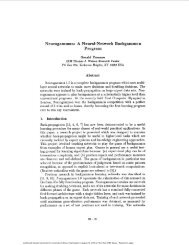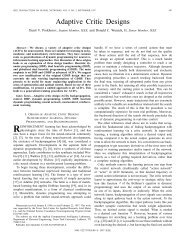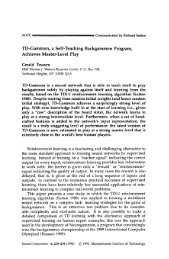Optimal Tracking Control for a Class of Nonlinear Discrete-Time ...
Optimal Tracking Control for a Class of Nonlinear Discrete-Time ...
Optimal Tracking Control for a Class of Nonlinear Discrete-Time ...
Create successful ePaper yourself
Turn your PDF publications into a flip-book with our unique Google optimized e-Paper software.
1856 IEEE TRANSACTIONS ON NEURAL NETWORKS, VOL. 22, NO. 12, DECEMBER 2011We let J L (e L (k)) = lim J [i+1] (e [i] (k)). Accordingly,i→∞v L (k) = limi→∞ v[i] (k) and e L (k) = limi→∞ e[i] (k) is the correspondingstates. Let x L (k) = e L (k) + η(k) and u L (k) =v L (k) + u s (k).In the following part, we will show that the per<strong>for</strong>manceindex function J L (e L (k)) satisfies the corresponding HJBfunction, and it is the optimal per<strong>for</strong>mance index function.Theorem 2: If the per<strong>for</strong>mance index function J i+1 (e i (k))is defined by (27). Let J L (e L (k)) = lim J [i+1] (e [i] (k)).i→∞Let v L (k) = limi→∞ v[i] (k) and e L (k) = limi→∞ e[i] (k) is thecorresponding states. Then the following equation can beestablished:( ) ( T ( TJ L e L (k) = e (k)) L Qe L (k) + v (k)) L Rv L( (k))+ J L e L (k + 1) . (45)Pro<strong>of</strong>: First, according to Theorem 1, we haveJ [i+1] (e [i] (k)) ≥ J [i] (e [i] (k)), ∀e [i] (k). So, we can obtain( ) ( TQe (TRvJ [i+1] e [i] (k) ≥ e (k)) [i] [i] (k)+ v (k)) [i−1] [i−1]( (k))+ J [i−1] e [i−1] (k + 1) . (46)Let i →∞,wehavev L (k) = limi→∞ v[i] (k) and( ) ( T ( TJ L e L (k) ≥ e (k)) L Qe L (k) + v (k)) L Rv L( (k))+ J L e L (k + 1) . (47){ On the other hand, <strong>for</strong> any i and arbitrary control policyμ [i] (k) } ,let [i+1] (e [i] (k)) be as (29). By Lemma 1, wehave( ) ( T ( TJ [i+1] e [i] (k) ≤ e (k)) [i] Qe [i] (k) + μ (k)) [i] Rμ [i]( (k))+ [i] e [i−1] (k + 1) . (48)Since μ [i] (k) in (48) is chosen arbitrarily. We let the controlpolicy {μ [i] (k)} ={v [i] (k)}, ∀i. So we can get( ) ( TJ [i+1] e [i] (k) ≤ e (k)) [i] Qe [i] (k) + (v [i] (k)) T Rv [i]( (k))+J [i] e [i−1] (k + 1) . (49)Let i →∞, and then we have( T ( TJ L (e L (k)) ≤ e (k)) L Qe L (k) + v (k)) L Rv L( (k))+J L e L (k + 1) . (50)Thus, combining (47) with (50), we have( ) ( T ( TJ L e L (k) = e (k)) L Qe L (k) + v (k)) L Rv L( (k))+J L e L (k + 1) . (51)Next, we give a theorem to demonstrate J L (e L (k)) =J ∗ (e ∗ (k)).Theorem 3: Let the per<strong>for</strong>mance index functionJ [i+1] (e [i] (k)) be defined as (27) and J L (e L (k)) =lim J [i+1] (e [i] (k)). J ∗ (e ∗ (k)) is defined as in (15). Then wei→∞have J L (e L (k)) = J ∗ (e ∗ (k)).Pro<strong>of</strong>: According to the definition J ∗ (e(k)) =infv(k)J(e(k), v(k)), we know thatJ [i+1] (e(k)) ≥ J ∗ (e(k)). (52)So <strong>for</strong> ∀e [i] (k), wehave( )J [i+1] (e [i] (k)) ≥ J ∗ e [i] (k) . (53)Let i →∞, and then ( we have) ( )J L e L (k) ≥ J ∗ e L (k) . (54)infv(k)On the other hand, according to the definition J ∗ (e(k)) =J(e(k), v(k)), <strong>for</strong> any θ > 0 there exists a sequence<strong>of</strong> control policy μ [i] (k), such that the associated per<strong>for</strong>manceindex function [i+1] (e(k)) similar as (29) satisfies [i+1] (e(k)) ≤ J ∗ (e(k)) + θ. From Lemma 1, we can getSo we haveJ [i+1] (e(k)) ≤ [i+1] (e(k)) ≤ J ∗ (e(k)) + θ. (55)( ) ( )J [i+1] e [i] (k) ≤ J ∗ e [i] (k) + θ. (56)Let i →∞, and then ( we can obtain) ( )J L e L (k) ≤ J ∗ e L (k) + θ. (57)Noting that θ is chosen ( arbitrarily, we have) ( )J L e L (k) ≤ J ∗ e L (k) . (58)From (54) and (58), ( we can get) ( )J L e L (k) = J ∗ e L (k) . (59)From Theorem 2, we can see that J L (e L (k)) satisfies HJBequation, so we have v L (k) = v ∗ (k). From (14) and (28), wehave e L (k) = e ∗ (k). Then we draw conclusion J L (e L (k)) =J ∗ (e ∗ (k)).After that, we give a theorem to demonstrate the state errorsystem (11) is asymptotically stable, i.e., the system state x(k)follows η(k) asymptotically.The following lemma is necessary <strong>for</strong> the pro<strong>of</strong> <strong>of</strong> stabilityproperty.Lemma 3: Define the per<strong>for</strong>mance index function sequence{J [i+1] (e [i] (k)) } as (27) with J [0] = 0, and the controlpolicy sequence { v [i] (k) } as (25). Then we have that <strong>for</strong>∀i = 0, 1,..., the per<strong>for</strong>mance index function J [i+1] (e [i] (k))is a positive definite function.Pro<strong>of</strong>: The Lemma can be proved by the following threesteps.1) Show That Zero Is an Equilibrium Point <strong>for</strong> (11): Forthe autonomous system <strong>of</strong> (11), let e(k − σ 0 ) = e(k − σ 1 ) =···=e(k − σ m ) = 0, we have e(k + 1) = 0. According to thefirst condition <strong>of</strong> Assumption 1, when e(k −σ 0 ) = e(k −σ 1 ) =···=e(k − σ m ) = 0, we have v(k) = 0. So according to thedefinition <strong>of</strong> equilibrium state in [1], we can say that zero isan equilibrium point <strong>for</strong> (11).









